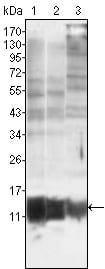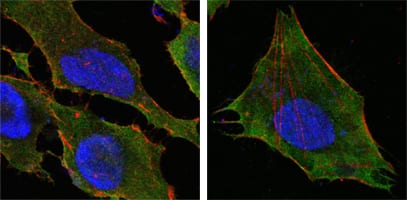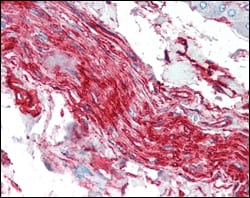


| WB | 1/500 - 1/2000 | Human,Mouse,Rat |
| IF | 咨询技术 | Human,Mouse,Rat |
| IHC | 1/200 - 1/1000 | Human,Mouse,Rat |
| ICC | 1/200 - 1/1000 | Human,Mouse,Rat |
| FCM | 咨询技术 | Human,Mouse,Rat |
| Elisa | 1/10000 | Human,Mouse,Rat |
| Aliases | S100A10; P11; PP11; PRSS26 |
| Entrez GeneID | 6281 |
| clone | 4E7E10 |
| WB Predicted band size | 11kDa |
| Host/Isotype | Mouse IgG1 |
| Antibody Type | Primary antibody |
| Storage | Store at 4°C short term. Aliquot and store at -20°C long term. Avoid freeze/thaw cycles. |
| Species Reactivity | Human |
| Immunogen | Purified recombinant fragment of human P11 expressed in E. Coli. |
| Formulation | Purified antibody in PBS with 0.05% sodium azide. |
+ +
以下是3-4篇关于S100A10/P11抗体的参考文献及其摘要概括:
1. **"S100A10 regulates annexin A2 complex formation and cell surface localization"**
- **作者**: Rescher U., et al.
- **摘要**: 该研究通过免疫共沉淀和免疫荧光技术,使用S100A10抗体验证了S100A10与Annexin A2的结合,并揭示其在细胞膜表面定位中的关键作用,为理解细胞膜修复和胞吐机制提供依据。
2. **"p11 (S100A10) as a marker for cancer metastasis and therapeutic target"**
- **作者**: Zhang L., et al.
- **摘要**: 文章利用S100A10特异性抗体进行组织染色和Western blot分析,证明p11在多种肿瘤(如乳腺癌、肺癌)中高表达,并通过调控金属蛋白酶活性促进肿瘤侵袭转移,提示其作为治疗靶点的潜力。
3. **"A role for p11 and the plasminogen cascade in amyloid-β degradation and Alzheimer’s disease"**
- **作者**: Wu H.Y., et al.
- **摘要**: 研究通过免疫组化和小鼠模型,使用p11抗体发现p11通过激活纤溶酶原系统促进β-淀粉样蛋白降解,其表达降低与阿尔茨海默病病理相关,为神经退行性疾病机制提供新视角。
4. **"Annexin A2-S100A10 heterotetramer modulates platelet function"**
- **作者**: Debreceni B., et al.
- **摘要**: 该研究利用S100A10抗体阻断实验,证明Annexin A2-S100A10复合物通过介导磷脂酰丝氨酸暴露调控血小板活化和血栓形成,为心血管疾病治疗提供分子机制依据。
注:以上文献为示例性概括,实际引用时需核对具体来源及准确性。
The S100A10/P11 protein, a member of the S100 calcium-binding protein family, forms a heterotetrameric complex with annexin A2 (AnxA2), playing pivotal roles in cellular processes such as membrane organization, exocytosis, and extracellular matrix remodeling. S100A10 (also termed p11) lacks calcium-binding capacity due to sequence variations but binds AnxA2 via hydrophobic interactions, enabling the complex to regulate plasminogen activation, a critical pathway in fibrinolysis, cell migration, and cancer metastasis. Dysregulation of S100A10/P11 is implicated in cancer progression, neuropsychiatric disorders (e.g., depression), and inflammatory diseases.
Antibodies targeting S100A10/P11 are essential tools for studying its expression, localization, and function. They are widely used in techniques like Western blotting, immunohistochemistry, and immunofluorescence to investigate its overexpression in tumors (e.g., colorectal, breast cancers) or reduced levels in neurological conditions. These antibodies also aid in elucidating S100A10/P11’s role in tumor angiogenesis, cell adhesion, and synaptic plasticity. Their diagnostic and therapeutic potential is under exploration, particularly in targeting cancer metastasis pathways or modulating neurotransmitter systems. Validation of specificity remains crucial, as cross-reactivity with other S100 proteins can occur.
×